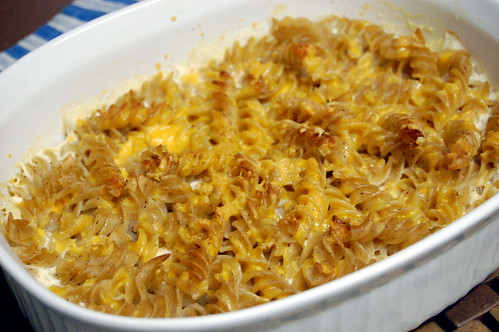Oh my gosh! They are so awesome! For one thing, they totally bring the crazy*. But, more than that, the glimpses into history are so fun and some of the recipes even sound pretty good. The turn-of-the-century books don't use measured oven temperatures, but they are still pretty neat. Especially the really old church cookbooks with recipes from all the ladies of the church.
First up: Macaroni and Cheese.
I used a recipe from Cookery Craft, the 1894 church cookbook of The South Church of St. Johnsbury, Vermont. It was submitted by one Mrs. Edward Ross.

Here's what I did:
1894 Macaroni and Cheese
Ingredients
1/2 pound pasta, cooked and drained (I used rotini instead of macaroni)
1 1/2 cups grated cheddar cheese
2 tablespoons butter
2 cups milk
salt, pepper, and garlic powder to taste
Directions
Preheat oven to 400 degrees.
Butter a casserole dish. Make one layer of pasta in the dish. Cover with half the cheese. Sprinkle with salt, pepper, and garlic powder. Evenly distribute small pats of butter. Cover with the rest of the pasta. Cover with remaining cheese. Sprinkle with salt, pepper, and garlic powder. Pour milk over all.
Bake for 30 minutes. Let sit for 5 minutes. Serve hot.
Verdict: It was okay but pretty bland. More cheese might have helped a bit. I probably wouldn't make it again, but I definitely had fun adapting a recipe from more than a hundred years ago.
*This is way too long to be a footnote, but whatever:
In one magazine, an issue of The Rotarian, there is an advertisement for advertisements. "Do you read the advertisements?" it asks. "It will pay you many times over to do so."
And the ads are insane. There's one for Baker's Chocolate titled "Chocolate Peppermint Cake: Wedding Bells for Janet," in which Janet is only able to score a husband because Janet's mother telegraphs her to remind her to only use Baker's Chocolate, not a "slightly cheaper" brand. Thanks to this intervention, Janet's cake is a success and her man-friend is impressed enough with her domesticity to enter into a life partnership. Because successful baking is the foundation of any good relationship.
Several cookbooks from the 1800s have entire sections devoted to cooking for "the Sick and Poor." One book includes, among other slightly more creatively titled items, the following recipes: "Soup for the Poor," "A Nourishing Soup for the Poor," and "An Excellent Soup for the Poor." Also, recipes for "Furmity" and "Flummery." And "Toast and Water," in which you toast a thick slice of bread until it is brown but not burnt, pour boiling water over it, and let it sit until cold. Nice.

No comments:
Post a Comment